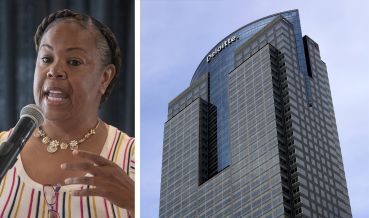Non-Office CRE Assets Could Bolster Debt Markets in 2024: NYU Schack Panelists
By Andrew Coen December 1, 2023 1:52 pm
reprints
The commercial real estate debt markets are poised for a more active 2024, driven — perhaps unsurprisingly — by non-office transactions, according to leading lenders at the 56th annual New York University-Schack Institute of Real Estate Capital Markets conference Thursday.
Miriam Wheeler, head of the global real estate financing group at Goldman Sachs (GS), said her firm is projecting roughly $64 billion of commercial mortgage-backed securities (CMBS) issuance in 2024 compared to less than $40 billion this year. Wheeler stressed that the 2024 CMBS volume will comprise a very small percentage of office properties, and most likely only in conduit transactions, but that many borrowers in other sectors are motivated to execute five-year refinance loans at fixed-rate terms rather than continuing to seek extensions.
“Office is going to continue to be a small percentage and probably only in the conduit, but other asset classes have enough cash flow to get it done, so I think you’ll see some more deals,” Wheeler said during the NYU conference’s global capital markets panel held at the New York Hilton-Midtown hotel.
The CMBS market has been largely muted in 2023 given the steady rise in interest rates over the past year and a half that created barriers for borrowers to achieve refinancings, especially in the office sector given hybrid working trends. Since last year’s NYU Schack capital markets panel, where lenders warned of a potential long-lasting absence from banks financing CRE deals, there have been six additional interest rate hikes by the Federal Reserve.
Wheeler said only around 25 percent of loans now in the current CMBS universe could achieve a refi from senior lenders. Banks, which historically have bought a high percentage of AAA-rated CMBS loans, have been largely absent from the market and insurance companies have become more selective, which has resulted in a small number of money managers to keep the market functioning, according to Wheeler.
The wheels are also in motion for a boost in lending activity for non-office assets from balance sheet lenders seeking to reduce their CRE exposure, according to Tim Johnson, global head of Blackstone Real Estate Debt Strategies.
“Given the liquidity challenges in office, it would make logical sense that one of the ways to reduce is just to run off the other asset classes to a certain extent and push those out into the refinancing market and get some activity going,” Johnson said. “It probably would make sense that the better assets get pushed into the market to get refinanced because they can be refinanced and the equity can deal with it.”
The global capital markets panel — moderated by Dino Paparelli, global head of commercial real estate at Deutsche Bank (DB) — also featured Jeffrey DiModica, president of Starwood Property Trust; Andrea Balkan, managing partner at Brookfield (BN); and Jesse Hom, head of real estate credit and capital markets at GIC.
Hom said the office sector may eventually play out similar to malls, which had their valuations peak in 2015 before fundamentals weakened due to changing consumer behaviors toward more e-commerce purchases coupled with oversupply. He noted that there remains CMBS market activity for top-tier malls in single-asset, single-borrower deals while middle-class assets have no bank support with lenders instead trying for modifications to amortize cash flow.
“And then you have the lower tier that are irrelevant and need to be demolished, redeveloped and reimagined,” Hom said. He said he foresees “office kind of bifurcating into those tiers and probably a similar theme shakeout.”
Balkan said the office sector may benefit over the long term on the supply front given that the development pipeline is “slow to nonexistent” and with construction financing harder to obtain, “only the really great projects are going to get done.”
In the near term, the CRE finance market will likely see some added volatility from the 2024 election cycle, but is unlikely to lead to any “massive change” in valuations, according to DiModica. He said “fiscal conservatism” in terms of reining in spending would be ideal to combat inflation and avoid higher interest rates, but noted that Donald Trump also ran up the federal deficit at high levels similar to President Joe Biden.
“I think this country is going to look at a higher-for-longer rate environment, because it’s what we don’t want but there’s simply too much Treasury supply that needs to roll over,” DiModica said.
“When rates start to go down there’s going to be a tremendous amount of corporate and high-yield supply, so there’s going to be a lot of impediments to going into lower rates, and they’re mostly driven by our lack of fiscal responsibility in this country on both sides.”
Andrew Coen can be reached at acoen@commercialobserver.com


